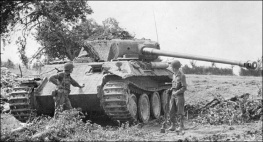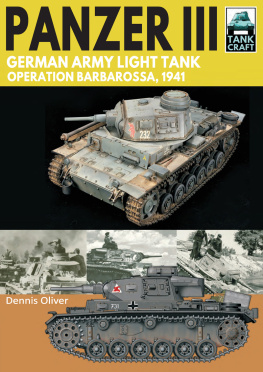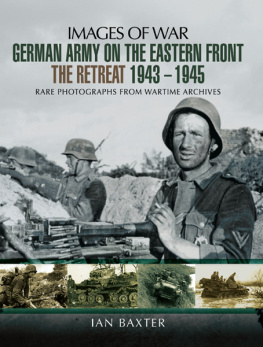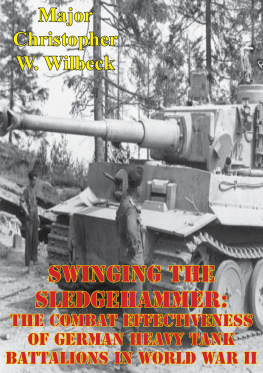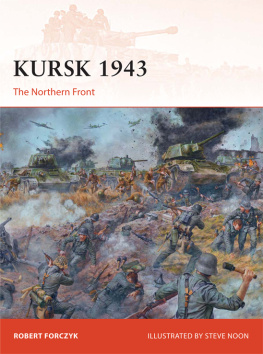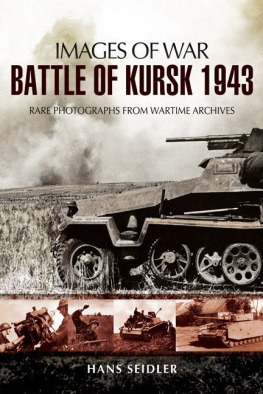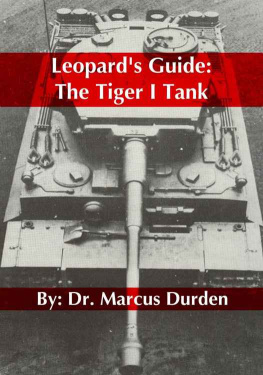
This early production Tiger I of 2.Kompanie, schwere Panzer-Abteilung 503 is also shown and discussed on page 24 of the Camouflage & Markings section. Note the Pzkpfw III stowage box, or Rommelkiste, the twin apertures for the periscope above the drivers visor and toggles on either side of the Kugelblende mounting. Note also that the stowage box appears to be painted in a slightly darker shade than the turret.
TankCraft 30
TIGER I
GERMAN ARMY HEAVY TANK EASTERN FRONT, 1942
Dennis Oliver
First published in Great Britain in 2021 by Pen & Sword Military
An imprint of Pen & Sword Books Ltd
47 Church Street, Barnsley, South Yorkshire, S70 2AS
Copyright Pen & Sword Ltd, 2021
Artwork copyright Dennis Oliver
ISBN 978 1 39901 808 1
ePUB ISBN 978 1 39901 809 8
Mobi ISBN 978 1 39901 809 8
The right of Dennis Oliver and Oliver Publishing to be identified as the Authors of this work has been asserted by them in accordance with the Copyright, Designs and Patents Act 1988.
A CPI catalogue record for this book is available from the British Library.
All rights reserved. No part of this book may be reproduced or transmitted in any form or by any means, electronic or mechanical including photocopying, recording or by any information storage and retrieval system, without permission from the publisher in writing.
Pen & Sword Books Ltd incorporates the Imprints of Pen & Sword Military, Pen & Sword Family History, Pen & Sword Maritime, Pen & Sword Aviation, Pen & Sword Discovery, Wharncliffe Local History, Wharncliffe True Crime, Wharncliffe Transport, Pen & Sword Select, Pen & Sword Military Classics, Leo Cooper, The Praetorian Press, Remember When, Seaforth Publishing and Frontline Publishing.
For a complete list of Pen 8i Sword titles please contact
PEN & SWORD LIMITED 47 Church Street, Barnsley, South Yorkshire, S70 2AS,
England
E-mail:
Website: www.pen-and-sword.co.uk
On Saturday, 29 August 1942, four Tiger I tanks of schwere Panzer-Abteilung 502, led by the battalion commander Major Richard Mrker, made their way through the dense, marshy forests south-east of Leningrad, modern-day St Petersburg, towards the German defensive line. Days earlier a Soviet attack had created a large bulge in the front between Sinyavino and the village of Gaitolovo and Major Mrker had been ordered to support the infantry units in the area. These four Tigers made up the battalions total complement of heavy vehicles at the time and Mrker protested vigorously that the employment of his tanks in such small numbers, in terrain that could not have been more unfavourable, would negate any advantage these powerful new vehicles may have enjoyed, including the element of surprise. But Hitler had insisted that the Tigers be sent into action as soon as possible, confident that the heavy Panzers would tip the balance in favour of the German units besieging Leningrad which he regarded as the birthplace of Bolshevism. Little or no thought had been given to the most basic logistical requirements and Major Mrkers men had been allowed just nine days to familiarise themselves with their new tanks. The battalion had no recovery vehicles or even spare parts.
By the end of the day not a single shot had been fired in anger and three of the four Tigers had been immobilised by mechanical failures. Although all three vehicles were later salvaged, the battalion would not be ready to take part in any further operations for almost a month. The first action of what was to become one of the legendary weapons systems of the Second World War could not have been more inauspicious.
This book is the seventh in the TankCraft series dealing with the Tiger I and Tiger II tanks and completes the story by focusing on the first vehicles to leave the production line and go into battle during late 1942. In addition, it examines the evolution of the heavy Panzer units which fought on the Eastern Front up to the spring of 1943 (). The failure of Operation Barbarossa to end the war in 1941 meant that new ways had to be found to defeat the Soviet Union and by the beginning of 1942 plans were well underway to equip the army with a new heavy tank and the development of what was to become the Tiger I is covered in the Technical Details and Modifications section. Other aspects were also subject to change including vehicle camouflage and this is also considered. I hope that a thorough examination of the matter, beginning as it does in the pre-war period, will give a greater appreciation of the colour schemes adopted, often unofficially, during the summer of 1942 which eventually led to the institution of the Dunkelgelb, or dark yellow, base colour with which I am sure most readers will be familiar.
Less than 100 Tiger tanks took part in the battles around Leningrad and the attacks to recapture Kharkov, the principal actions covered by this book, and the available photographs were often taken under atrocious conditions and sometimes at great risk. These factors go some way towards explaining the mediocre quality of some of the images reproduced in this book but I have decided to include a number as they are directly relevant to the units and vehicles described. The lack of clarity in some photographs has also led to a certain amount of speculation on my part in the creation of the illustrations but where this has occurred I have tried to make it clear.

An early production Tiger I of 8.Kompanie, SS-Panzer-Regiment 2 photographed in the streets of Kharkov in March 1943. The companys ten Tigers were all assembled in December 1942 and points to note here are the toolbox and 15-ton jack on the hull rear plate, the metal exhaust covers and S-mine dischargers. Just visible above the toolbox is the regiments unit insignia. The trackguards, both with triangular end sections, have been removed and placed on the engine deck. Note also the large stowage box which partly covers the pistol port and was a common feature of this companys tanks. The 20-litre fuel containers, or Wehrmacht Einheitskanister, behind the stowage box are probably painted in Dunkelgrau RAL 7021
Notes
. The period following this is covered in TankCraft 20, Tiger I: German Army Heavy Tank Eastern Front, Summer 1943.

The map at left depicts Eastern Europe with national borders as they were in June 1941 when the invasion of the Soviet Union began. The front in what is today the Baltic States, northern Russia, Belarus and northern Ukraine remained relatively static for much of 1942. As a result of the German efforts to push towards the oil fields of the Caucasus region, codenamed Fall Blau or Case Blue, the focus of operations for much of the year shifted to the vast expanse of land between the present-day Georgian frontier and Stalingrad on the Volga River and this area is shown in the small inset map. Limited assaults around Leningrad, modern St Petersburg, and in the sector of Heeresgruppe Mitte were designed to draw the Russians away from the southern front. The broken line in both maps indicates the front as it was in mid-November 1942, just prior to the launch of the Red Armys offensive to cut off Stalingrad, and the shaded area in the large map denotes territory recaptured by the Soviets up to early February 1943. The timeline presented below details the events that occurred between August 1942, when the first Tigers arrived on the Eastern Front, and March 1943 when the events chronicled in TankCraft 20, Tiger I: German Army Heavy Tank Eastern Front, Summer 1943 begin.



